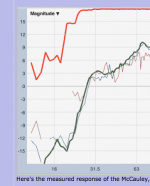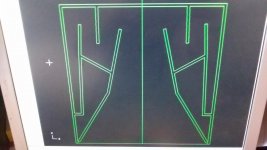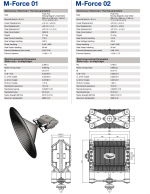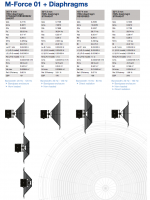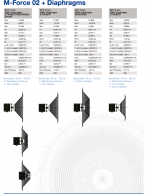Hey Guys,
In keeping with the Martin-Audio tradition try this : Professional Loudspeaker Systems. Martin Audio Ltd.
In keeping with the Martin-Audio tradition try this : Professional Loudspeaker Systems. Martin Audio Ltd.
I only know Wayne's sub (2x12"). I don't know if it can compete in the same race. He and Danley are two best designers.
Bass Horn subwoofer
AudioRoundTable.com: Pi Speakers => Pi 12 sub plns please?
Here's Wayne's measurement of his sub. This measurement is at 10 meters; add twenty dB to compare it to 1M measurements. This is with 2400 watts.
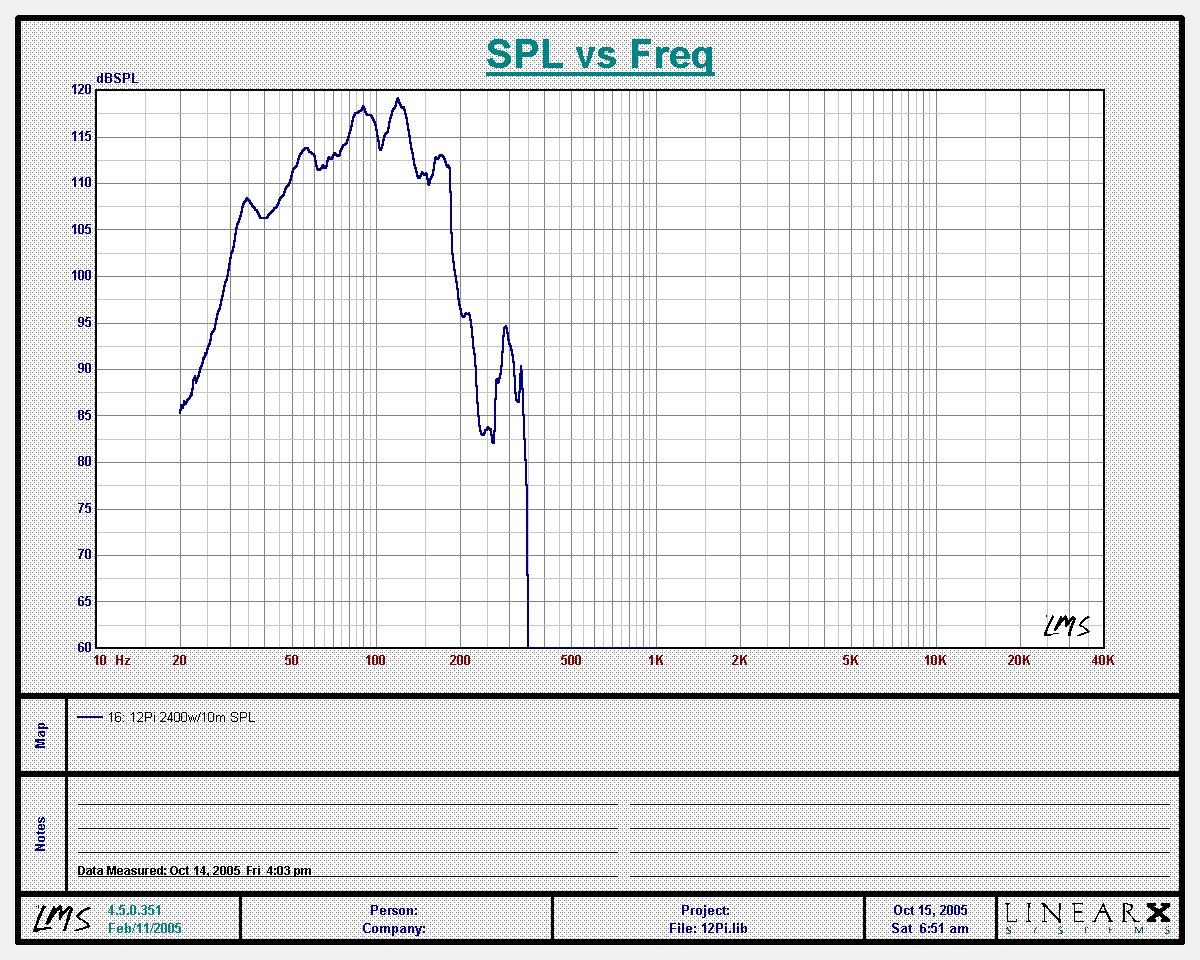
Here's my sims of the McCauley M421 and TH-Mini. Note that this is a *sim*, and the mini is getting more watts than it can physically handle.
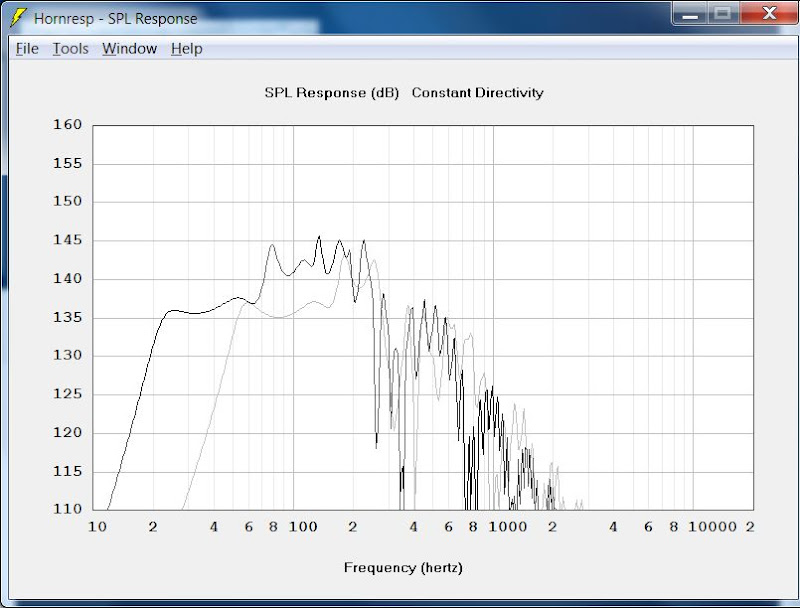
Some observations:
1) th-mini is crazy sensitive considering it's footprint. I can see why Danley moved away from front loaded horns. Even if the output per cubic foot was identical, the tapped horns are much much easier to manufacture
2) Wayne's sub detonated during testing, with 2400 watts.
3) The McCauley sub goes lower than both, but WOW is that a big heavy expensive box. (The drivers alone cost $3400 versus about $203 for a TH-Mini and about $330 for the Pi sub)
One thing that's a bit of a mystery to me is why the rolloff of the tapped horn is shallower than the sims would predict; sims say 24dB per octave but Jeff Knorr's measurements are showing about 12dB per octave. Odd.
Last edited:
I had to show this...the mother of all subwoofers
THE BIGGEST HORN SUB OF THE WORLD by Roberto Delle Curti ITALY
THE BIGGEST HORN SUB OF THE WORLD by Roberto Delle Curti ITALY
I had to show this...the mother of all subwoofers
THE BIGGEST HORN SUB OF THE WORLD by Roberto Delle Curti ITALY
Wow, I haven't seen this posted....
this week
I`d say for "long throw " ( whatever that is !) then a block of 8 Terrahorns has always impressed me by how damn far the sub travels!
The Terrahorn
.p.
The Terrahorn
.p.
The M421 drops off at about 36 dB per octave below Fb.3) The McCauley sub goes lower than both, but WOW is that a big heavy expensive box. (The drivers alone cost $3400 versus about $203 for a TH-Mini and about $330 for the Pi sub)
One thing that's a bit of a mystery to me is why the rolloff of the tapped horn is shallower than the sims would predict; sims say 24dB per octave but Jeff Knorr's measurements are showing about 12dB per octave. Odd.
The lack of coherency (red line) indicates the bump at 16 Hz is from some outside noise, probably wind or a passing truck.
Art
Attachments
Hi! It's been ages since I've been on this forum. I saw this thread a while now and have always wondered if a single 18" horn can be modeled using the same folding as the Martin audio 215 mk III with consideration given to the mouth size since it will use only a single driver. I I haven't been around to using horn response so I would really appreciate some help. I have heard the mkIIIs and I totally agree that the bass is truly gut wrenching.Martin 215 mk 2 - Speakerplans.com Forums - Page 20.... A decent driver I might say http://www.rcf.it/products/precision-transducers/low-frequency-transducers/l18p400...
I had the help from Neo Dan with my last two subs and is still very happy with them. I just want to explore a bit more on something new...
I had the help from Neo Dan with my last two subs and is still very happy with them. I just want to explore a bit more on something new...
Stewin,hi all i thought the lab sub was the greatest long throw, in terms of low distortion and high spl . o.k how about bass maxx subs??
BassMaxx changed it's name to BassBoss in 2013.
In the 2007 Tulsa Sub Shootout, the 12Pi (Wayne P's larger version of a LabSub using push pull Lab 12 drivers with external cooling) went louder and lower than the BassMaxx.
There have been large improvements in driver technology in the last 16 years, the Lab 12 is no longer anywhere near the greatest in terms of low distortion and high SPL, though it still is a decent driver for the cost.
Art
Stewin,
BassMaxx changed it's name to BassBoss in 2013.
In the 2007 Tulsa Sub Shootout, the 12Pi (Wayne P's larger version of a LabSub using push pull Lab 12 drivers with external cooling) went louder and lower than the BassMaxx.
There have been large improvements in driver technology in the last 16 years, the Lab 12 is no longer anywhere near the greatest in terms of low distortion and high SPL, though it still is a decent driver for the cost.
Art
Hi Art, I find your posts in this thread very interesting! You talk quite a bit about transient response related to different cabinet alignments.
Some discussions I've read seem to think that the transient response or "punch factor" is merely related to frequency response in the upper bass/kick region of the system, to me your posts seem to challenge that statement.
You claim FLH has the best transient response, could this be due to the natural rising response in many FLH cabinets which exaggerates the upper bass region versus the lower regions? Would TH/BR/FLH cabinets with careful EQ measurements for the same frequency response still have their characteristic impact, making it more a alignment design feature rather than only related to frequency register?
I have a set of quality FLH's, aswell as a pair your keystones and I can attest that the FLH's I have comes out on top regarding the impact but I'm trying to EQ the keystone to perform somewhat equal in that regard.
They are both very clean sounding but the typical character of the cabinets seem hard to manipulate.
Last edited:
The Matterhorn is still by far the "loud and clear" winner. Nothing much has has changed as far as I know since posts #8 and #10.thanks welter . which is now the best loud and clear according to your opinion sir??
Osse,1)Some discussions I've read seem to think that the transient response or "punch factor" is merely related to frequency response in the upper bass/kick region of the system, to me your posts seem to challenge that statement.
2)You claim FLH has the best transient response, could this be due to the natural rising response in many FLH cabinets which exaggerates the upper bass region versus the lower regions?
3)Would TH/BR/FLH cabinets with careful EQ measurements for the same frequency response still have their characteristic impact, making it more a alignment design feature rather than only related to frequency register?
4)I have a set of quality FLH's, aswell as a pair your keystones and I can attest that the FLH's I have comes out on top regarding the impact but I'm trying to EQ the keystone to perform somewhat equal in that regard.
They are both very clean sounding but the typical character of the cabinets seem hard to manipulate.
1)I think both frequency and phase response through the crossover region are important regarding transient response.
2) In general FLH have a smoother upper frequency and phase response than TH, therefore better transient response, and are easier to integrate with top cabinets.
3) Different cabinet designs can be equalized to have similar frequency and phase response, but the native (unequalized) response ultimately dictates the output when pushed to the limits. Using a design that has a similar native response curve to the intended playback material will reveal less of the cabinet's limitations when pushed hard.
4)Many FLH have good response to well over 200 Hz, so can cover the entire "punch" range. The Keystone is limited to around 125 Hz before the upper frequency and phase problems become apparent, requiring top cabinets capable of similar output in the crossover region to "play nice". Crossed over at 100 Hz or below with a 24 dB per octave slope, I would not be able to detect much (if any) difference in transient response between the Keystone TH and a FLH with similar frequency response.
Art
In my previous response I had forgot Powersoft's development of the M-force moving magnet driver since posts 8 & 10. The claims of 150+ dB at one meter from a single driver look very possible, but have yet to see any actual measured response of cabinets utilizing the drivers.thanks welter . which is now the best loud and clear according to your opinion sir??
Attachments
The M-force is a good design for Band-Pass enclosures and bass-reflex type, it could go to around 145 dB but there is no way it could go to 150 dB in the sub passband. Not even the 40" one. Very hard to get it to work as a sub in a horn even with the flexible parameters.In my previous response I had forgot Powersoft's development of the M-force moving magnet driver since posts 8 & 10. The claims of 150+ dB at one meter from a single driver look very possible, but have yet to see any actual measured response of cabinets utilizing the drivers.
Osse,
1)I think both frequency and phase response through the crossover region are important regarding transient response.
2) In general FLH have a smoother upper frequency and phase response than TH, therefore better transient response, and are easier to integrate with top cabinets.
3) Different cabinet designs can be equalized to have similar frequency and phase response, but the native (unequalized) response ultimately dictates the output when pushed to the limits. Using a design that has a similar native response curve to the intended playback material will reveal less of the cabinet's limitations when pushed hard.
4)Many FLH have good response to well over 200 Hz, so can cover the entire "punch" range. The Keystone is limited to around 125 Hz before the upper frequency and phase problems become apparent, requiring top cabinets capable of similar output in the crossover region to "play nice". Crossed over at 100 Hz or below with a 24 dB per octave slope, I would not be able to detect much (if any) difference in transient response between the Keystone TH and a FLH with similar frequency response.
Art
Interesting, thanks! I have used the stones on 3 gigs so far and they definately pack a nice mix of spl/extension /punch for what I do.. merciless power on the tap for sure. Gonna hook them up tomorrow again for some heavy duty techno! Can't wait.
- Status
- This old topic is closed. If you want to reopen this topic, contact a moderator using the "Report Post" button.
- Home
- Loudspeakers
- Subwoofers
- Most powerful long throw sub?
